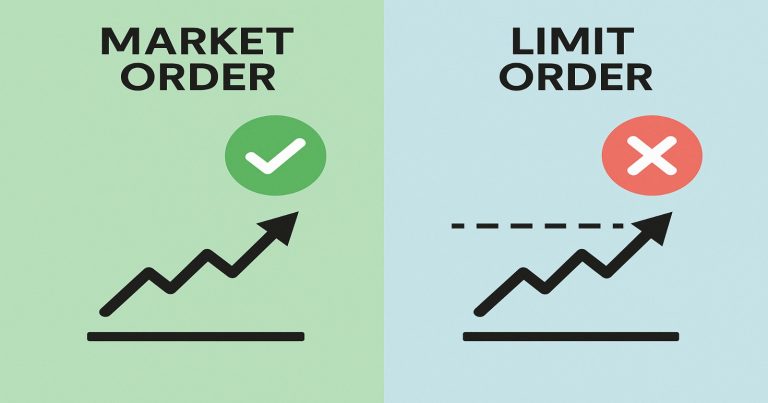In the financial trading world, knowing what separates a market order from a limit order aids one in making the most informed decisions about such transactions. There are two fundamental ways through which traders execute orders- market orders and limit orders-and each offers different advantages as well as disadvantages. The market order gives a higher preference to the speed, usually at the cost of the control of the price. The limit order gives control of the execution price to the traders, even if waiting longer for the completion of a trade is the cost paid. This article explores market order and limit order in detail, including how each function, ideal scenarios for their use, and what factors are most crucial to be taken into consideration.
Difference Between Market Order and Limit Order
The difference mainly between market order and limit order rests in the balance of the speed of execution with price control. Both types of orders have relative advantages and disadvantages depending on the market conditions and your trading strategy.
| Feature | Market Order | Limit Order |
|---|---|---|
| Execution Speed | Executed only when the target price is met | Executed only when target price is met |
| Price Control | No control over execution price | Full control over execution price |
| Risk of Price Slippage | High in volatile markets | Lower risk as price is predetermined |
| Order Priority | High priority due to immediate execution | Lower priority until price target is achieved |
| Best For | Quick entry/exit in high liquidity | Targeted trades with specific price goals |
| Order Fill Assurance | Almost guaranteed fill | No guarantee of fill if the price target is unmet |
| Cost Consideration | Prone to cost variation with market shifts | Fixed cost, as price is pre-set |
Choosing between these orders depends on various factors like market volatility, liquidity, and your preferred balance between execution speed and price control.
What is Market Order?
A market order is just an instruction to buy or sell a security at the current market price. Since this order type looks for execution immediately, it is one of the quickest types of orders that have been utilized to get into or out of any position, especially within the most liquid markets.
How Does a Market Order Work?
When you place a market order, the broker or trading platform matches it with the best available price. Here’s a breakdown:
- Buy with Market Order: You are quoted on the best available ask, or selling, price when you make a buy market order.
- Sell with Market Order: You are quoted at the best available bid, or buying, price when you make a sell market order.
Market orders are widely applied in day trading because some price needs to be captured very fast. However, it comes with the risk of price slippage due to volatility. This relates to the difference between the execution price and the one at the time when the order was placed.
Factors to Know Before Placing a Market Order
- Market Liquidity: High liquidity reduces order imbalances and yields higher efficiency in executing market orders.
- Order Size: Large orders might cause partial fills and different prices for the entire order as the order hits more than one level.
- Execution Time: Market orders are executed instantly within trading hours and may be kept separate for time-sensitive trades.
- Volatility Concerns: Slippage can arise from volatile market prices that change dramatically in a short time and hit the execution price.
- Trading Costs: Namely fees or commissions, in case such applies, especially when trading in markets with wider bid-ask spreads.
What is a Limit Order?
A limit order allows a trader to place the price at which he or she is willing to buy or sell a security. This is the difference between a limit order and a market order: the former directs the minimum possible price at which the order might be executed instead of its immediate execution.
How Does a Limit Order Work?
A limit order only executes if the market price reaches the target price set by the trader. Here’s how it works:
- Buy Limit Order: A buy limit order placed at $50 means that the order will get executed only if the price goes down to $50 or below.
- Sell Limit Order: A sell limit order placed at $100 means that the order gets executed if the price goes up to $100 or higher.
A Limit Order A limit order is very popular among traders who know what they want and, therefore, do not feel pressure to execute any of their trades. Limit orders do help reduce the risk of overpaying for security when buying (in the case of a buy limit order) or selling too low (in the case of a sell limit order).
Things to Know Before Placing a Limit Order
- Market Condition Awareness: When the market condition is low or volatile, it may take time for the limit price.
- Price Control Advantage: Limit orders prevent losing traders from adverse price movements because of the limitation in execution at a particular fixed price.
- Uncertain Fill Rate: A fill rate can’t be guaranteed when the price does not reach the target limit. Hence, the trading strategy may go awry.
- Order Expiry Options: Most of the brokers accommodate day-only or “Good-Til-Canceled” (GTC) limit orders, which offer options for traders.
- Trading Cost Control: Use of predetermined prices mainly through limit orders keeps trading costs in control since trades only take place at desired price levels.
Limit Order and Market Order FAQs
What is the difference between market order and limit order?
The primary difference lies in price control and execution speed. A market order prioritizes immediate execution at the current price, while a limit order provides price control by executing only when the specified price is met. Market orders are faster but lack price assurance, while limit orders allow specific price targets but may not execute immediately.
How does slippage affect market orders?
Slippage occurs when the execution price differs from the quoted price due to rapid price changes, especially in volatile markets. Market orders are vulnerable to slippage as they prioritize speed over price control, which can result in higher or lower execution costs than expected.
Are limit orders useful in volatile markets?
Yes, limit orders are particularly beneficial in volatile markets as they offer price control, preventing trades from executing at unfavorable prices. This is especially useful for investors with precise entry or exit points, as it ensures that trades occur within the specified price range.
Can I cancel a market order?
No, once a market order is placed, it typically executes almost immediately and cannot be canceled. Limit orders, however, can be modified or canceled if the price target hasn’t been reached yet, providing flexibility.
Is it possible to place a market order outside of trading hours?
Market orders generally execute only during regular trading hours and will not execute outside these hours. However, some trading platforms allow pre-market and after-hours trading using limit orders, which may execute if the specified price is met during these sessions.


